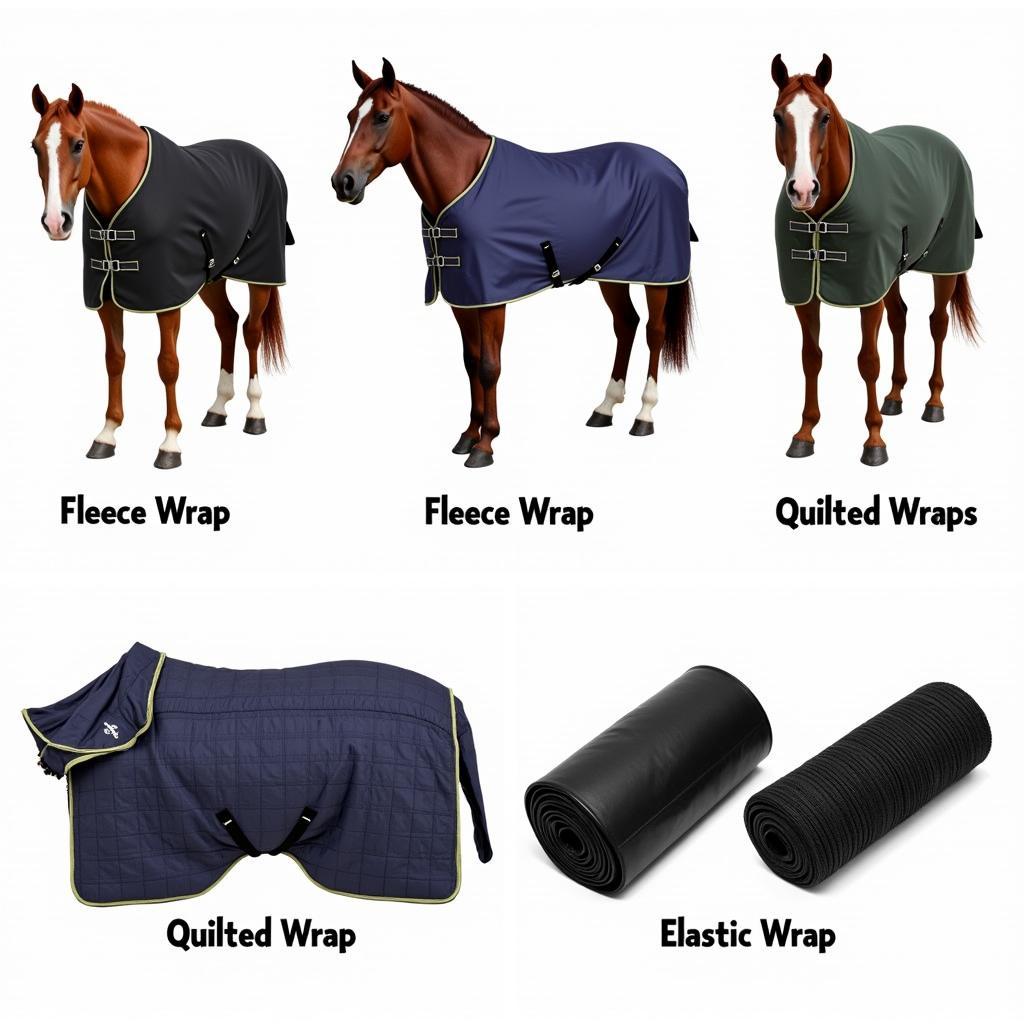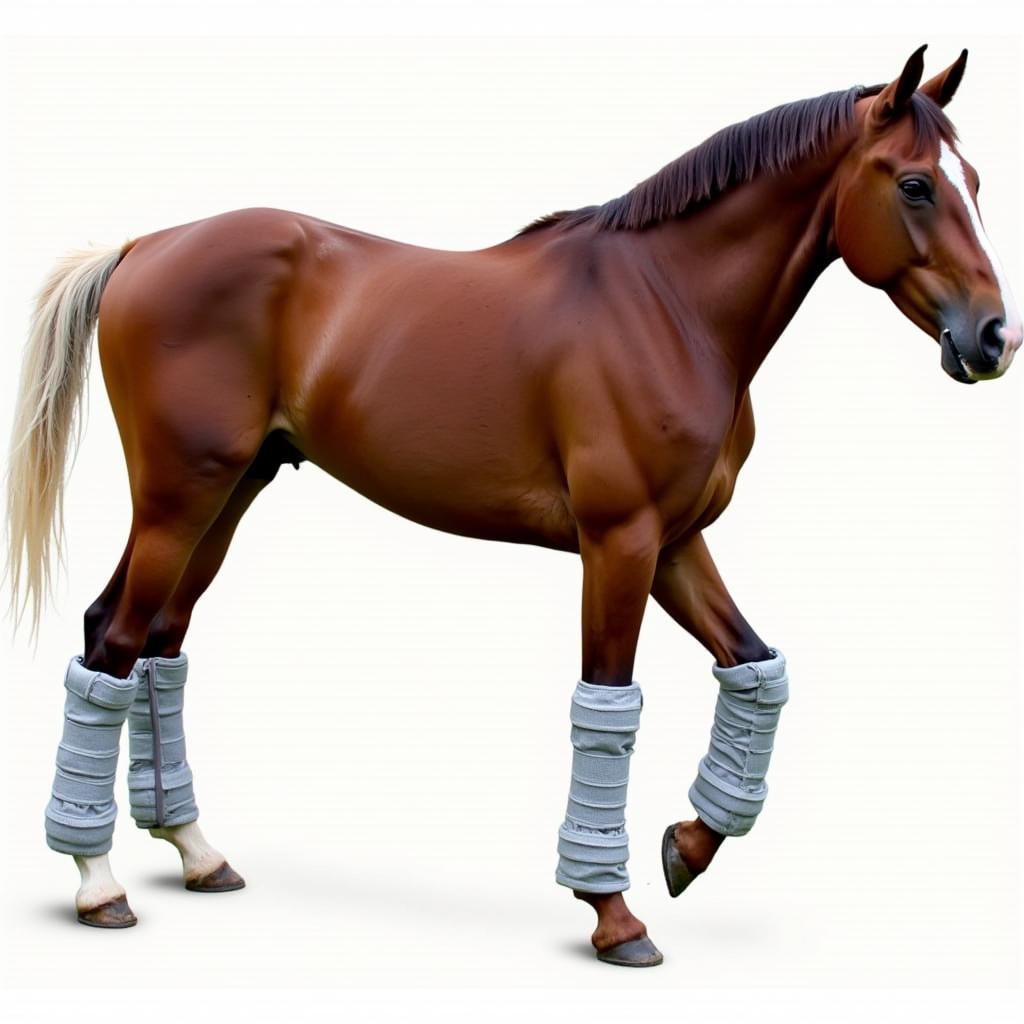Standing wraps are an essential part of any horse owner’s toolkit, offering support, protection, and helping to prevent injuries. But with so many different types and brands available, choosing the best standing wraps for your equine partner can feel overwhelming. This comprehensive guide is here to help you navigate the world of standing wraps, ensuring you make the best decision for your horse’s well-being.
 Different Types of Standing Wraps
Different Types of Standing Wraps
Understanding the Importance of Standing Wraps
Horses, especially those in training or recovering from injuries, can benefit significantly from wearing standing wraps. These wraps provide a number of key advantages:
- Support for tendons and ligaments: Standing wraps offer gentle compression to the lower legs, providing vital support to the tendons and ligaments, particularly during periods of rest or stall confinement. This support helps reduce strain and minimize the risk of injuries.
- Prevention of swelling: The compression from standing wraps helps promote blood circulation, which can be particularly beneficial after strenuous exercise or in cases of minor injuries. Improved circulation helps reduce inflammation and prevents fluid buildup that can lead to swelling.
- Protection from knocks and bumps: Standing wraps act as a protective barrier against accidental knocks and bumps in the stable or paddock, reducing the risk of injuries to the delicate skin and bones of the lower legs.
- Warmth and comfort: Certain types of standing wraps, such as fleece wraps, offer additional warmth and insulation to the legs, particularly beneficial during colder months or for horses prone to stiffness.
 Horse Wearing Standing Wraps
Horse Wearing Standing Wraps
Types of Standing Wraps: Finding the Right Fit
Choosing the right type of standing wrap depends on your horse’s specific needs and the intended purpose. Here’s a breakdown of the most common types:
- Fleece Wraps: These wraps are known for their softness, breathability, and ability to provide excellent cushioning. They are a popular choice for daily use, offering warmth and support.
- Quilted Wraps: Made from durable woven fabric with a quilted pattern, these wraps offer a higher level of support compared to fleece wraps. They are often preferred for horses engaged in more strenuous activities or for use during transportation.
- Elastic Wraps: These versatile wraps are highly adjustable, allowing for a custom fit and varying degrees of compression. They are commonly used during exercise or for therapeutic purposes.
Choosing the Best Standing Wraps: Key Factors to Consider
Navigating the variety of standing wraps involves considering several key factors to ensure you select the optimal option for your horse:
- Material: The material should be breathable, durable, and comfortable against your horse’s skin. Consider the climate and your horse’s individual needs when selecting the material.
- Size and Fit: Standing wraps come in various sizes. Measuring your horse’s legs accurately is crucial for a proper fit. Wraps that are too tight can restrict blood flow, while loose wraps can slip and pose a tripping hazard.
- Closure Mechanism: Secure closure is essential to prevent the wraps from unraveling. Velcro closures are popular for their ease of use, while hook and loop closures offer added security.
- Intended Use: The type of wrap you choose should align with its intended purpose. Fleece wraps are suitable for daily wear, while quilted wraps may be more appropriate for transport or competition.
- Durability and Care: Opting for high-quality wraps that can withstand regular use and washing is essential. Check the manufacturer’s care instructions to ensure longevity.
“Choosing the right standing wraps goes beyond just picking a color or brand,” advises Dr. Emily Carter, an equine veterinarian with over 20 years of experience. “Understanding your horse’s individual needs, the intended purpose of the wraps, and the importance of proper application is crucial for maximizing their benefits and ensuring your horse’s well-being.”
Applying Standing Wraps Correctly: A Step-by-Step Guide
Proper application is key to ensuring your horse reaps the full benefits of standing wraps and minimizing the risk of complications. Follow these steps for safe and effective application:
- Preparation: Start with clean, dry legs. Ensure your horse is calm and standing on level ground.
- Positioning the Wrap: Begin wrapping just below the knee, rolling the wrap downwards, ensuring even pressure throughout.
- Overlapping Layers: Overlap each layer of the wrap by approximately 50%, maintaining consistent tension to avoid uneven pressure points.
- Avoiding Wrinkles: Smooth out any wrinkles or twists as you wrap. Wrinkles can create pressure points and cause discomfort.
- Securing the Closure: Secure the closure snugly but not too tight. You should be able to comfortably fit two fingers between the wrap and your horse’s leg.
- Checking for Circulation: After application, check for proper circulation by pressing on your horse’s hoof. The color should return quickly, indicating good blood flow.
Conclusion
Selecting the best standing wraps for your horse requires careful consideration of their individual needs and the intended purpose. By understanding the different types of wraps, key features, and the importance of correct application, you can provide your equine companion with the support and protection they need to thrive.
Need help choosing the best standing wraps for your horse? Our team at Justus Horses USA is here to help! Contact us at 0772127271, email us at [email protected], or visit us at QGM2+WX2, Vị Trung, Vị Thuỷ, Hậu Giang, Việt Nam. We are available 24/7 to assist you.